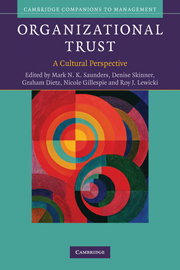Book contents
- Frontmatter
- Contents
- List of figures
- List of tables
- Note on editors
- Note on contributors
- Foreword
- Editors' acknowledgements
- Part I The conceptual challenge of researching trust across different ‘cultural spheres’
- Part II Trust across different ‘cultural spheres’: inter-organizational studies
- Part III Trust across different ‘cultural spheres’: intra-organizational studies
- 11 The role of trust in international cooperation in crisis areas: a comparison of German and US-American NGO partnership strategies
- 12 Antecedents of supervisor trust in collectivist cultures: evidence from Turkey and China
- 13 Trust in turbulent times: organizational change and the consequences for intra-organizational trust
- 14 The implications of language boundaries on the development of trust in international management teams
- 15 The dynamics of trust across cultures in family firms
- Part IV Conclusions and ways forward
- Index
- References
14 - The implications of language boundaries on the development of trust in international management teams
Published online by Cambridge University Press: 05 June 2012
- Frontmatter
- Contents
- List of figures
- List of tables
- Note on editors
- Note on contributors
- Foreword
- Editors' acknowledgements
- Part I The conceptual challenge of researching trust across different ‘cultural spheres’
- Part II Trust across different ‘cultural spheres’: inter-organizational studies
- Part III Trust across different ‘cultural spheres’: intra-organizational studies
- 11 The role of trust in international cooperation in crisis areas: a comparison of German and US-American NGO partnership strategies
- 12 Antecedents of supervisor trust in collectivist cultures: evidence from Turkey and China
- 13 Trust in turbulent times: organizational change and the consequences for intra-organizational trust
- 14 The implications of language boundaries on the development of trust in international management teams
- 15 The dynamics of trust across cultures in family firms
- Part IV Conclusions and ways forward
- Index
- References
Summary
Summary
This chapter explores the concept of language boundaries in international teams in multinational companies which use English as their shared working language. Drawing on research in the fields of intercultural communication theory and sociolinguistics, and on references in the management literature, the analysis demonstrates how language boundaries in teams both foster trust within parties and hinder trust between parties. Empirical data from interviews with international executives illustrate how English as a shared working language can create as well as break down language boundaries. The chapter identifies the implications these boundaries have on the formation and maintenance of trust through cooperation and relationship building. Findings show that it is an awareness of language practices and sociolinguistic competence rather than expert language knowledge that fosters the development of trust in multicultural, multilingual teams.
Introduction
Many management teams in multinational companies are not only multicultural, but also multilingual as they are composed of speakers of different mother tongues. The language factor has become omnipresent in international organizations, and globalization implies that they conduct their operations in multiple language environments and through multilingual teams (Feely and Harzing, 2003; Welch et al., 2001). Language differences are often considered to be an obstacle and the concept of the language barrier is therefore a familiar one in such organizations. Indeed, it is so well known that its implications are often overlooked. Language barriers are visible obstacles to communication and occur when individuals who do not speak and understand each other's languages have difficulties working together.
- Type
- Chapter
- Information
- Organizational TrustA Cultural Perspective, pp. 358 - 382Publisher: Cambridge University PressPrint publication year: 2010
References
- 4
- Cited by



